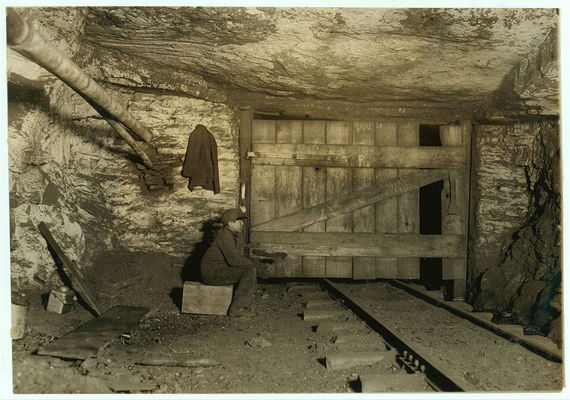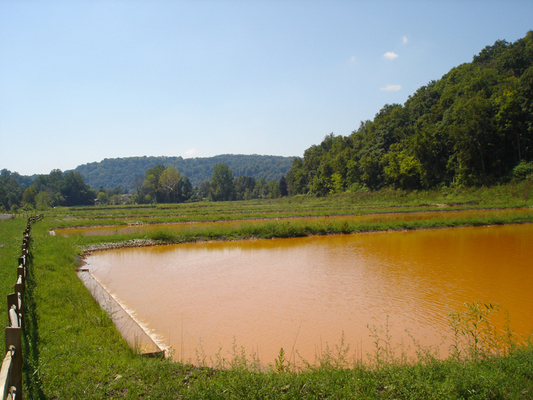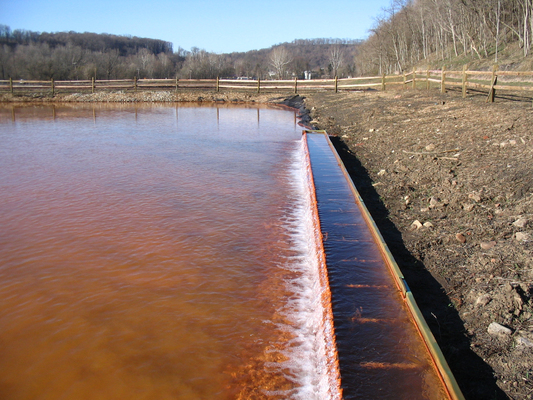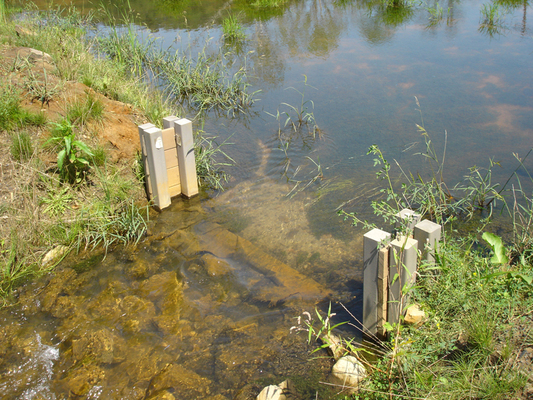
by Nicole Branan Thursday, January 5, 2012

A young miner in Pittston, Pa., in 1911. Over the past 200 years, miners have extracted billions of tons of coal in Pennsylvania, but drainage from abandoned mines has left the waterways polluted. Library of Congress

Large settling ponds aerate mine discharge, allowing dissolved iron to oxidize. Over time, iron oxide settles to the bottom and the clear water flow out. Courtesy of Method Media

These troughs spread and slow the water's flow, giving it time for chemical reactions to occur and for the iron oxide to settle to the bottom. Courtesy of Method Media

A passive treatment system at the abandoned Marchand mine in Pennsylvania reduces the water's iron, turning its color from bright orange to clear, as shown here. Bob Hedin
The billions of tons of coal that miners extracted from Pennsylvania’s ground over the past two centuries have long gone up in smoke, but their legacy lives on in the state’s rivers and waterways. Nasty discharge — often with sky-high metal concentrations — from thousands of abandoned coal mines has been polluting Pennsylvania’s streams and groundwater.
“Abandoned mine drainage is the number one environmental problem in the state of Pennsylvania and possibly in the whole Appalachian region,” says William Burgos, an environmental engineer at Penn State University in University Park. Cleanup options exist, but their individual price tags are in the millions. And the companies that originally operated the mines are long gone, leaving responsibility to the state, which often can’t shoulder the immense cost. Now a new technology implemented at the abandoned Marchand mine in southwestern Pennsylvania promises to become the world’s first economically self-sustaining mine drainage treatment system, restoring streams while turning the collected metals into a commercial product.
The case of the Marchand mine near the town of Lowber is typical for underground coal mines in Pennsylvania. Coal production at the site was booming in the early 1900s until the mine closed within four decades. But like all mining activities, extracting Lowber’s natural wealth had a negative side effect: unearthing rocks and minerals — most notably pyrite — that had never been exposed to air. Oxygen quickly started to eat away at the fresh surfaces, initiating chemical reactions that extracted iron and produced sulfuric acid. Over time, rain and groundwater filled the mine, and in 1942, an iron-laden stream began pouring out of the mine portal and into nearby Sewickley Creek.
Although mine drainage is often acidic — and therefore toxic to aquatic life — the water at Marchand passes through alkaline rock before gushing out of the ground, which neutralizes its acidity. This eliminates the problem of toxic, low pH levels, but the enormous amount of dissolved iron that pours out of the mine has harmed the environment for more than 60 years. Once the mine water meets the air, dissolved iron oxidizes, forming a brightly colored solid oxide, often affectionately called “yellow boy,” says Philip Sibrell of the U.S. Geological Survey in Kearneysville, W.Va. “This precipitate coats the bottom of streams and that chokes out aquatic life.”
Treatment systems for such mine drainage fall into two categories: active and passive. Active treatments require large amounts of chemicals, pumps and other energy-consuming equipment to remove iron from the water. Passive technologies, however, make use of gravity and natural materials and processes. A typical passive treatment system consists of settling ponds — human-made ponds designed to collect contaminated water and hold it until contaminants either settle out of the water or natural chemical reactions clean the water. While the iron oxide slowly sinks to the bottom of the ponds, the relatively clean water drains into a nearby constructed wetland that filters out any remaining impurities. Such passive systems are less costly than chemical treatments and require much less maintenance, but they only work if the iron oxide that builds up in the ponds is periodically removed. However, removing and disposing of the sludge costs money, which usually isn’t there, and the sludge can be toxic so disposing of it is not easy. “So, often these systems were eventually just abandoned as failures,” says Robert Hedin, president of Hedin Environmental and Iron Oxide Recovery in Pittsburgh, Pa., and designer of the new Marchand treatment system.
In 1995, Hedin wondered if he could turn iron oxide waste into a product and thereby make it more affordable to collect or treat. “We started collecting sludge from different passive treatment systems, analyzed it, and it turned out that it could be used as a colorant,” he says. Five years later, he started selling his iron oxide product to Hoover Color Corporation, which uses it to make environmentally friendly pigments for paints, coatings, cement-based products and plastics. Hoover’s EnvironOxide™ Pigments won the BuildingGreen Corporation’s Top 10 Green Building Products award in 2003.
By removing the sludge, Hedin and his team restored functionality to several passive treatment systems throughout Pennsylvania. But none of these systems could have kept up with the one ton of iron oxide that drains out of the Marchand mine every day. That amount of iron oxide would have clogged the ponds too quickly, reducing the water’s settling time so dramatically that much of it would have just flown through. So when the Sewickley Creek Watershed Association asked Hedin to design a treatment technology for Marchand, he and his team proposed creating a new type of passive treatment system that would keep up with the large amounts of iron oxide and allow him to collect and sell it. “It sounded like a win-win situation; we would not only clean up the stream, but also recover enough material to at least maintain the system,” says Tom Keller, the association’s executive director. “So we went for funding and started the project.”
With a $1.2 million Growing Greener grant from the Pennsylvania Department of Environmental Protection, Hedin built six large connected settling ponds and constructed a wetland on an eight-hectare area next to the mine outlet. The system directs the enormous volume of discharge — up to 2,450 gallons per minute — into specially designed troughs that spread out the flow and decrease its speed. That’s important because the water needs to spend enough time in the ponds for the chemical reactions to occur and the oxide to settle out. “The fact that this system treats such a high-flow discharge is one of the really striking aspects of it,” Burgos says. “Current passive mine drainage systems work fine up to maybe 50 or 100 gallons per minute, but when you are talking 1,000 or 2,000 gallons per minute, current technologies are really challenged. In fact, many high flows have essentially been left untreated because treatment systems would be overwhelmed by the volume.”
In the ponds, the discharge is aerated so that all dissolved iron oxidizes and settles to the bottom. And once one pond has filled with iron oxide sludge, water is diverted to the next pond so that treatment continues while the iron oxide is recovered. “This is a great system,” Burgos says, “and it’s a good example of what needs to be done if the acid mine drainage problem is going to be solved in a cost-effective way.”
During the first year of operation, the Marchand treatment reduced iron concentrations in Sewickley Creek from an average of 74 milligrams per liter to less than 1 milligram per liter, which means the stream now meets the Pennsylvania Department of Environmental Protection’s water quality standards. “Before building the system, the stream never met the DEP’s in-stream standard for iron,” Hedin says. And because the system requires no energy input, maintenance costs are low. “Gravity is doing the work for us, and oxygen and time are our main reactants,” he says. In 2008, Hedin’s company and the Sewickley Creek Watershed Association received the Pennsylvania Governor’s Award for Environmental Excellence for the Marchand project.
Hedin’s technology works on alkaline mine drainage, but — with slight modifications — can also treat moderately acidic discharge. That makes the system suitable for treating the majority of abandoned underground mines in southwestern Pennsylvania, Hedin says. However, other abandoned mines in Pennsylvania and across the country pour out highly acidic water that his technology can’t handle. “That’s unfortunate,” he says, “because those discharges kill a lot of streams, but we are working on that.”
© 2008-2021. All rights reserved. Any copying, redistribution or retransmission of any of the contents of this service without the expressed written permission of the American Geosciences Institute is expressly prohibited. Click here for all copyright requests.